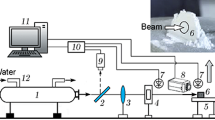Abstract
The use of aluminum borides is a promising direction in the development of modern propellant compositions and aerial vehicles. We present experimental data on the kinetics of oxidation of microscale powders of aluminum, amorphous boron, and the aluminum borides AlB2 and AlB12 in air upon heating at a constant rate of 10°C/min and the results of laser-assisted ignition of high-energy materials that contain these metal powders and are based on ammonium perchlorate, ammonium nitrate, and an inert binder or an energetic combustible binder. We show that the use of the boron-containing powders enables us to lower the onset temperature of oxidation and the temperature of intense oxidation, while increasing their oxidation effectiveness, compared to pure aluminum. The dependences of ignition delay time on the heat flux show that the AlB2 and AlB12 powders are the most effective metal fuel components for solid propellants based on ammonium perchlorate, ammonium nitrate, and an energetic binder: they display the shortest ignition delay time and require the lowest heat input for ignition.



Similar content being viewed by others
REFERENCES
E. L. Dreizin, Prog. Energy Combust. Sci. 35 (2), 141 (2009). https://doi.org/10.1016/j.pecs.2008.09.001
A. Gromov, L. T. Deluca, A. P. Il’in, U. Teipel, A. Petrova, and D. Prokopiev, Int. J. Energ. Mater. Chem. Propul. 13 (5), 399 (2014). https://doi.org/10.1615/IntJEnergeticMaterialsChemProp.2014011255
Energy-Intensive Fuels for Aviation and Rocket Engines, Ed. by L. S. Yanovskii (Fizmatlit, Moscow, 2009) [in Russian].
D. S. Sundaram, V. Yang, and V. E. Zarko, Combust., Explos. Shock Waves 51 (2), 173 (2015). https://doi.org/10.1134/S0010508215020045
Y. Sun, K. L. Chintersingh, M. Schoenitz, and E. L. Dreizin, J. Phys. Chem. C 123 (18), 11807 (2019). https://doi.org/10.1021/acs.jpcc.9b03363
X. Liu, J. Gonzales, M. Schoenitz, and E. L. Dreizin, Thermochim. Acta 652, 17 (2017).
D. Yu, C. Kong, J.-K. Zhuo, S. Q. Li, and Q. Yao, Sci. China: Technol. Sci. 58 (12), 2016 (2015). https://doi.org/10.1007/s11431-015-5841-0
V. Arkhipov, L. Savelieva, and P. Ponomarev, MATEC Web Conf. 110, 01075 (2017). https://doi.org/10.1051/matecconf/201711001075
V. A. Arkhipov, A. S. Zhukov, V. T. Kuznetsov, N. N. Zolotorev, N. A. Osipova, and K. G. Perfil’eva, Combust., Explos. Shock Waves 54 (6), 689 (2018). https://doi.org/10.1134/S0010508218060084
A. G. Korotkikh, V. A. Arkhipov, I. V. Sorokin, and E. A. Selikhova, Khim. Fiz. Mezoskop. 20 (1), 5 (2018).
M. L. Whittaker, R. A. Cutler, and P. E. Anderson, MRS Online Proc. Libr. 1405, 96 (2011). https://doi.org/10.1557/opl.2012.64
D. Liang, R. Xiao, J. Liu, and Y. Wang, Aerosp. Sci. Technol. 84, 1081 (2019).
S. Adil and B. S. Murty, Thermochim. Acta 678, 178306 (2019).
M. L. Whittaker, H. Y. Sohn, and R. A. Cutler, J. Solid State Chem. 207, 163 (2013).
I. Zhukov, A. Vorozhtsov, V. Promakhov, Y. Dubkova, A. Zhukov, and A. Khrustalev, MATEC Web Conf. 243 (00015), 1 (2018). https://doi.org/10.1051/matecconf/201824300015
D. A. Yagodnikov, A. V. Voronetskii, and V. I. Sarab’ev, Combust., Explos. Shock Waves 52 (3), 300 (2016). https://doi.org/10.1134/S0010508216030072
V. V. Promakhov, M. Kh. Ziatdinov, I. A. Zhukov, S. A. Vorozhtsov, A. E. Matveev, and S. S. Titov, Polzunov. Vestn., No. 4-1, 76 (2016).
I. A. Zhukov, M. K. Ziatdinov, A. B. Vorozhtsov, A. S. Zhukov, S. A. Vorozhtsov, and V. V. Promakhov, Russ. Phys. J. 59 (8), 1324 (2016). https://doi.org/10.1007/s11182-016-0911-8
S. L. Guseinov, S. G. Fedorov, A. Y. Tuzov, S. I. Malashin, A. I. Drachev, M. R. Kisilev, B. V. Pevchenko, and O. V. Voron’ko, Nanotechnol. Russia 10 (5–6), 420 (2015). https://doi.org/10.1134/S199507801503009X
N. V. Kirillova, A. I. Kharlamov, and S. V. Loichenko, Inorg. Mater. 36 (8), 776 (2000). https://doi.org/10.1007/BF02758596
A. G. Korotkikh, K. V. Slyusarskii, and I. V. Sorokin, Khim. Fiz. Mezoskop. 22 (2), 164 (2020). https://doi.org/10.15350/17270529.2020.2.16
Funding
This work was supported by the Russian Foundation for Basic Research, project no. 20-03-00588.
Author information
Authors and Affiliations
Corresponding author
Ethics declarations
The authors declare that they have no conflicts of interest.
Additional information
Translated by A. Kukharuk
Rights and permissions
About this article
Cite this article
Korotkikh, A.G., Sorokin, I.V., Slyusarskiy, K.V. et al. Ignition of Boron-Containing High-Energy Materials Based on an Oxidizer and Polymer Binder. Tech. Phys. 66, 895–901 (2021). https://doi.org/10.1134/S1063784221060104
Received:
Revised:
Accepted:
Published:
Issue Date:
DOI: https://doi.org/10.1134/S1063784221060104




